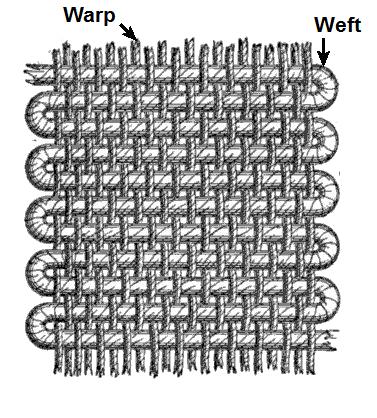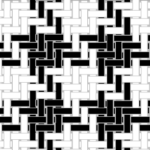The way a fabric is created determines the way it looks, the way it hangs, the way it feels. From light and sheer to heavy and shiny, the weave determines the very character of a garment. When it comes to men’s clothing we only have to consider two basic types of weaving, but the variety within those weaves is almost endless.
Plain Weave
Plain weaves are defined by their simple over-under weave. The warp threads (those running vertically) alternate going over and under the weft threads (those running horizontally), just as the weft alternates going over and under the warp.

Poplin
A popular and common weave, poplin gets its name from the Pope having a residence in the town where it was once made. Poplin was originally made with a thicker weft, giving it a corded appearance and texture. Modern poplins use the same size threads for warp and weft, making it smoother but also a bit sheer. Poplin fabrics are usually used for formal dress shirts and tend to have solid colors.
Broadcloth
Broadcloth is made with a normal plain weave like the poplin, but it is woven wider than its intended final width. Traditionally, it was stretched while immersed in water; when it dried, the fabric shrank to its intended size. Finally, the fabric was rubbed with special earth and beaten with wooden hammers to bind the individual fibers together, similar to a felting process. Because of this processing, broadcloth is softer and heavier than poplin, but it can still be used in formal situations.
Oxford
A number of new fabrics being made in the 19th century bore the names of famous universities like Cambridge and Yale. Today, only the Oxford cloth remains. It is a more casual fabric for shirts and is made using a basket weave that makes the cloth heavier but still breathable. A basket weave differs from the poplin in that instead of single threads alternating going over and under each other, pairs of threads – both the warp and the weft – alternate going over and under. Often, Oxfords are woven with two different colored threads, producing a checkerboard pattern that blends to a single color when viewed from a distance.

Pinpoint Oxford
Often shortened to just “pinpoint,” this version of the Oxford can be distinguished by a finer thread and a higher thread count – producing a softer fabric than an Oxford with more opacity than a poplin. Pinpoint weaves are for occasions that are more formal or professional.
Twill Weave
A twill is known by the diagonal patterns produced by the weave. In their simplest form, these diagonal lines are produced by the weft thread passing under two warp threads and then over one. This passing over of the weft thread is called a float. The float then shifts to the right one warp thread on the next weft thread.

A basic twill presents a diagonal line either going up and to the left or up and to the right, but by reversing the direction of the twill at regular intervals (herringbone) or alternating the colors of the warp and weft (houndstooth) an endless number of patterns can be created. Twill weaves are denser than poplins so they will be less breathable but also more weatherproof.
Twill weaves are also often used for pants for and there are a couple of good reasons for this. Because threads in twill weavwes interlace fewer times than do plain-woven threads, they tend to be softer and drape better. Twill’s uneven surface also makes it better at hiding stains than a sheer fabric.
- Denim – made of cotton and warp-heavy: the warp passes over two or more weft threads while going under one.
- Chino – originally made of 100% cotton, chinos are made of lighter thread than denim and are often blended with synthetic fibers.
- Gabardine – invented by Thomas Burberry (yes, that Burberry) in the 19th century, gabardine is a waterproof outerwear fabric that was originally made of wool and cotton.
We are barely scratching the surface of the subject, but this is a good introduction to the basic weaves used in men’s garments. Be warned: Once you learn to see the weave in garments, you cannot turn back.
If there’s anything you think I missed, please let me know in the comments!
Resources used in the article:
http://www.ctshirts.com/weaves-explained?cnt=weaves-explained
http://www.office-dress-shirts.com/shirt-fabrics.html
http://dappered.com/2014/07/a-primer-on-shirt-fabrics-poplin-vs-pinpoint-vs-twill-more/
http://www.realmenrealstyle.com/dress-shirt-fabrics/
https://en.wikipedia.org/wiki/Cambric
https://en.wikipedia.org/wiki/Twill
https://en.wikipedia.org/wiki/Houndstooth
https://www.cs.arizona.edu/patterns/weaving/monographs/ics_506.pdf



